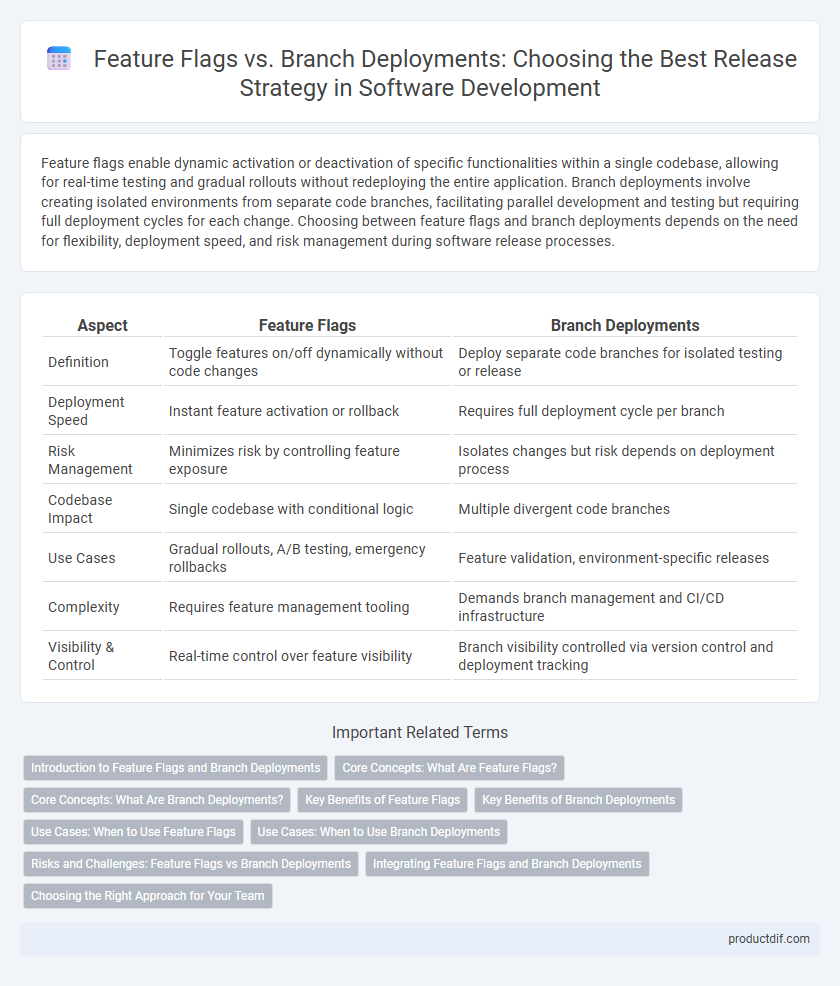Feature flags enable dynamic activation or deactivation of specific functionalities within a single codebase, allowing for real-time testing and gradual rollouts without redeploying the entire application. Branch deployments involve creating isolated environments from separate code branches, facilitating parallel development and testing but requiring full deployment cycles for each change. Choosing between feature flags and branch deployments depends on the need for flexibility, deployment speed, and risk management during software release processes.
Table of Comparison
| Aspect | Feature Flags | Branch Deployments |
|---|---|---|
| Definition | Toggle features on/off dynamically without code changes | Deploy separate code branches for isolated testing or release |
| Deployment Speed | Instant feature activation or rollback | Requires full deployment cycle per branch |
| Risk Management | Minimizes risk by controlling feature exposure | Isolates changes but risk depends on deployment process |
| Codebase Impact | Single codebase with conditional logic | Multiple divergent code branches |
| Use Cases | Gradual rollouts, A/B testing, emergency rollbacks | Feature validation, environment-specific releases |
| Complexity | Requires feature management tooling | Demands branch management and CI/CD infrastructure |
| Visibility & Control | Real-time control over feature visibility | Branch visibility controlled via version control and deployment tracking |
Introduction to Feature Flags and Branch Deployments
Feature flags enable developers to toggle features on or off in production without deploying new code, allowing for controlled feature rollouts and A/B testing. Branch deployments involve deploying code from specific branches to separate environments, facilitating isolated testing and parallel development workflows. Both methods improve software release agility but differ in operational complexity and risk management strategies.
Core Concepts: What Are Feature Flags?
Feature flags are a software development technique that allows teams to enable or disable specific functionality within an application without deploying new code. They provide granular control over features, enabling gradual rollouts, A/B testing, and quick rollbacks, enhancing continuous delivery and reducing deployment risks. Unlike branch deployments, feature flags decouple feature release from code integration, streamlining the delivery pipeline and improving operational agility.
Core Concepts: What Are Branch Deployments?
Branch deployments enable software teams to deploy code changes from feature branches directly to production-like environments without merging into the main branch. This approach facilitates isolated testing, allowing developers to validate new features or fixes independently while maintaining continuous integration stability. Unlike feature flags that toggle functionality within the same codebase, branch deployments create separate deployment instances tied to specific branches, enhancing parallel development workflows and reducing release risk.
Key Benefits of Feature Flags
Feature flags enable real-time, granular control over feature releases without the need for separate code branches, significantly reducing deployment risks and accelerating release cycles. They allow for targeted testing and gradual rollouts, enhancing user experience by minimizing disruptions and facilitating quick rollback if issues arise. This approach supports continuous integration and continuous delivery (CI/CD) by promoting seamless feature toggling and faster feedback loops.
Key Benefits of Branch Deployments
Branch deployments enable isolated testing environments that mirror production, reducing integration risks and facilitating parallel development workflows. They provide developers with the flexibility to deploy entire code branches, ensuring comprehensive validation of new features before merging. This approach enhances collaboration, accelerates debugging, and improves release confidence by delivering fully tested, cohesive updates.
Use Cases: When to Use Feature Flags
Feature flags enable controlled feature rollouts, allowing teams to test new functionality in production without the risk of full release, making them ideal for gradual user exposure and A/B testing. They support continuous integration and deployment workflows by decoupling code deployment from feature activation, enhancing flexibility for quick rollbacks and targeted feature exposure. Use feature flags when rapid iteration, controlled experimentation, and minimizing risk during deployment are priorities.
Use Cases: When to Use Branch Deployments
Branch deployments are ideal for complex feature development that requires isolated environments for end-to-end testing and validation before integration. They facilitate parallel workstreams by enabling separate teams to develop, test, and debug features independently without impacting the main codebase. Use branch deployments when comprehensive code changes demand thorough quality assurance and integration testing to prevent conflicts and maintain production stability.
Risks and Challenges: Feature Flags vs Branch Deployments
Feature flags introduce operational complexity and risk of exposing unfinished features to users, requiring rigorous testing and continuous monitoring to prevent feature toggling errors. Branch deployments face challenges with code divergence, merge conflicts, and delayed integration, increasing the risk of inconsistent production environments and longer feedback cycles. Both approaches demand strong coordination between development and operations teams to mitigate risks related to deployment stability and rollback procedures.
Integrating Feature Flags and Branch Deployments
Integrating feature flags with branch deployments enables continuous delivery by decoupling code release from feature activation, allowing teams to merge and deploy incomplete features safely. Feature flags provide granular control to toggle functionalities on or off in real time, while branch deployments isolate changes for testing and validation, reducing merge conflicts and deployment risks. This combined approach accelerates release cycles, enhances collaboration, and minimizes rollback scenarios in modern software development workflows.
Choosing the Right Approach for Your Team
Feature flags enable gradual feature rollouts and quick rollbacks without redeploying code, enhancing continuous delivery and minimizing risk for development teams. Branch deployments provide isolated environments for testing and collaboration, ensuring stability before merging into the main branch. Selecting the right approach depends on your team's release cadence, risk tolerance, and operational complexity.
Feature Flags vs Branch Deployments Infographic

 productdif.com
productdif.com